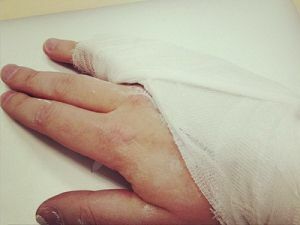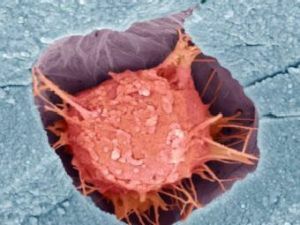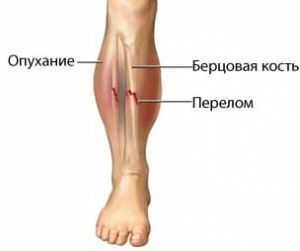 Hand - the upper limb of man - the main organ of labor, which in the process of evolution acquired mobility, having lost the function of support for the body.
Hand - the upper limb of man - the main organ of labor, which in the process of evolution acquired mobility, having lost the function of support for the body.
The structure of the most important working tool of a person is determined by its functions, as well as by the features of the tissues that form it.
The skeleton of the hand is conventionally divided into the bones of the upper limb belt, which are represented by paired bones of the clavicle and the scapula, and the bones of the fingers, forearms and humerus are the components of the free part of the upper limb.
The list of functions of the human arm's skeleton is quite wide: dynamic, sensory, static, performed by the brush, as well as connective and motor, related to the bones of the upper extremity belt, gave the person the ability to work in different types.
Contents of the article
- Contents of the article
- Concept and causes of injury
- Types of fractures of the upper extremity
- Symptoms and signs of hand injury
- Diagnostic approach
- First aid
- Methods of treatment
- Rehabilitation after injury
- Consequences of injury
- Forecast and timing of treatment
Understanding and causes of injury
Under the arm fractureunderstand the trauma of the limb, associated with a violation of the integrity of the bone and the subsequent separation of its parts.
Among the most common factors provoking a fracture:
- unsuccessful fall with the support of the hand;
- excessive load on the limb, weakened by chronic disease( osteoporosis);
- hits different directions and strength.
Types of fractures of the upper limb
Hand injuries are classified according to the characteristics of the fracture, its location and severity.
The following are the main approaches for determining the types of fracture of the hand:
- By type of damage : open( violation of the integrity of the skin at the site of the injury with the possible movement of
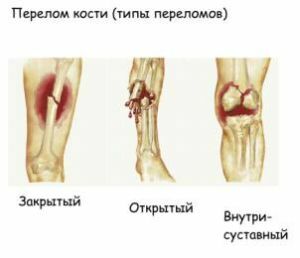 bone breaking out);closed( characterized by the integrity of the skin).
bone breaking out);closed( characterized by the integrity of the skin). - The number of damaged bones : isolated and multiple.
- Depending on the location of the bone damage line : diaphyseal( fracture occurs on the body of the bone);metaphyseal( the line of fracture is located between the body and the end of the bone);intraarticular( fracture along the line of epiphyseal cartilage, accompanied by rupture of ligaments, joint damage and displacement of bone fragments).
- In the direction and nature of the fracture line : longitudinal( the damaged surface is parallel to the longitudinal axis of the bone);screw-base( the line of the fracture resembles a spiral);T and B shaped;stellate;oblique and transverse( the zone of damage is located at an angle and perpendicular to the bone, respectively).
- Based on the presence / absence of the offset. Fracture of the arm with displacement may be primary( occurs at the time of injury due to force applied to the bone) and secondary( formed by the action of attached to the injured bones of muscle tissue).The displacement of the bone can be angular, rotational, along the length or width of the limb.
- Depending on the ability to move fragments : stable( no bias) and unstable( accompanied by a secondary displacement of parts of the damaged bone).
- By the presence / absence of complications .Complicated fractures can lead to bleeding, infection, fat embolism, and blood infection.
Separately it is necessary to note injuries of the hand according to the type of bones.
So, there are fractures:
- Brachial bone - long tubular bone, which is an intermediate link between the scapula and the elbow joint. In
 , depending on the location and features of the structure of this part of the skeleton, fractures of the upper, middle and lower parts of the humerus are distinguished.
, depending on the location and features of the structure of this part of the skeleton, fractures of the upper, middle and lower parts of the humerus are distinguished. - Clavicles - curved tubular bone most often in its middle part( diaphysis) due to a fall or a direct impact.
- Blades , which has a triangular, slightly curved shape and connects between the collarbone and the humerus. This kind of fracture is extremely rare. This is due to the location of the bone in the thickness of the muscles, its shape and relative mobility.
- The elbow joint , formed by the ulnar, brachial and radial bones. Trauma occurs due to weakness of tendons and elbows as a result of falling on an elongated arm or elbow.
- The radius of the arm , which is a pair of bones in the forearm. The most frequently diagnosed fracture of the lower third of its part.
- The wrists of are parts of the skeleton of the upper limb located between the forearm and the metacarpal bones and consisting of eight bones. Fractures of this department are classified according to the injured component of the bone;a phalanx of a finger having a brittle tubular structure.
Symptoms and signs of hand injury
For all types of hand fractures, the following signs and symptoms are typical:
- Pain occurring at the bone fracture site of .Sometimes it can give to adjacent areas, for example, in the case of an ulnar injury, pain is palpable in the area of the shoulder and forearm. The pain syndrome is quite intense and intensifies with movement or additional load on the limb.
- Bruising and swelling of the , which is especially pronounced with a fracture of the wrist, elbow joint, fingers.
- Deformation of the damaged area , diagnosed in cases with fractures with displacement. It is often visualized with injuries of the forearm and humerus.
- Restriction of mobility near joints .So, in case of violation of the integrity of the radius, there will be a restriction of movements in the radiocarpal joint.
- Crunch of bone fragments .The symptom is more typical for injuries of the elbow or shoulder.
- Coldness of the limb .Witnesses the violation of blood circulation due to damage to large main arteries and is a very alarming signal.
- The formation of the hematoma - profuse hemorrhage in the subcutaneous tissues.
- Violation of the sensitivity of the hand and fingers , which occurs as a result of damage to the nerves at the time of fracture.
Diagnostic approach of
Some of the described symptoms are not unambiguous, they can manifest themselves during dislocations, ligament injuries, bruises, therefore for the diagnosis of a fracture of the hand, X-ray examination is used.
In rare cases, a CT scan may be required. If the nerves are damaged, an examination of the neurologist is necessary.
First aid
 In case of a suspicion of a fracture, the first thing to do is to to immobilize the damaged section of the .To this end, the tire is placed from improvised materials, for example, planks or strong rods.
In case of a suspicion of a fracture, the first thing to do is to to immobilize the damaged section of the .To this end, the tire is placed from improvised materials, for example, planks or strong rods.
The construction is pribintovyvayem to the damaged segment and ensure its immobility.
Open fractures of the hand are characterized by bleeding.
In this situation, the wound must be treated with a disinfectant( green, iodine) and apply a pressure bandage / tourniquet.
The location of the overlay is determined based on the type of bleeding:
- in the case of arterial( blood gushing, has a bright red color) - just above the injured area, a tourniquet is superimposed;
- with venous( dark blood flows with a jet) - a pressure bandage is applied.
For analgesia, you can use any drug for this purpose( analgin, ketorolac, aspirin, etc.).However, if you have not previously encountered an existing medicine, it is better not to apply any measures and wait for an ambulance.
Methods of treatment
Most often in the case of a hand injury, conservative treatment is used, the essence of which is immobilization of the injured limb with the use of gypsum - a rigid fixing bandage.
In the case of a closed uncomplicated fracture, a closed reposition of the bone is performed - the return of its individual parts to the correct position.
In case of comminuted injuries, operative methods of treatment are used. Reposition of bone fragments with the help of pins( plates) is performed. These titanium devices are usually removed after adhesion, sometimes they are not removed at all to avoid highly probable complications.
Rehabilitation after injury
Behind the main stage of treatment, a fracture of the hand is followed by rehabilitation measures aimed at restoring the motor activity of the injured limb.
After 2-3 days from the moment of injury, they begin active movement of gypsum-free arm sections. 
After 3-10 days, interference currents and ultraviolet irradiation of a healthy hand can be assigned, thereby reducing pain and swelling, improving blood circulation at the site of injury.
At the same time, the patient can proceed to isotonic muscle strains in the area of injury.
After 2 weeks,
- magnetotherapy is prescribed;
- laser therapy;
- UHF;
- ultrasound;
- electrophoresis solution of novocaine.
The variety and number of procedures are selected individually.
After removal of gypsum and inflammation, mud therapy, coniferous and salt baths, as well as active physical therapy exercises. All exercises are aimed at developing a damaged joint and should be of a regular nature( 10-15 repetitions 3-4 times a day).
The sets of exercises for each of the hand segments are individual.
After 8-10 weeks, you can proceed to a light massage of the damaged area, the intensity of which increases as the formation of a good callus.
The final stage in the restoration of limb functions is occupational therapy - easy work at home, in the garden, handicrafts, etc.
Consequences of injury
Puffiness is one of the most common consequences of fracture of the limb, which is usually temporary.
In the case of a long period of swelling of the tissues, special procedures such as electrophoresis, phonophoresis, ultraviolet radiation and electrical muscle stimulation are necessary. Do not interfere with massage and therapeutic exercises.
Among folk methods of treatment, edema is compress from wormwood and wrapping the damaged area with blue clay.
This will help light massage, salt bath. Also it is necessary to adjust the food, spend more time in the fresh air, take vitamin B 12 and actively move. You may need an acupuncture course.
Prognosis and timing of treatment
The overall treatment period( including the rehabilitation period) for different arm zones varies:
- Cervical shoulder: treatment term - 3 months, rehabilitation - 1 month.
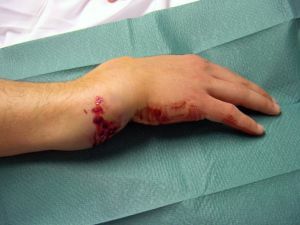
- Body of humerus: term of treatment - 4, rehabilitation - 1,5.
- Bones of the forearm: term of treatment - 2, rehabilitation 1.
- Radius: treatment period - 1.5, rehabilitation 1.5.
- Bones of the brush: the duration of treatment - 2, rehabilitation 1.5.
- Fingers: duration of treatment - 1, rehabilitation 1.
If there are contractures of the joints, the recovery period will be significantly extended and will be about six months.
If the injury has caused nerve damage or infection, it may take several years for a complete recovery.

